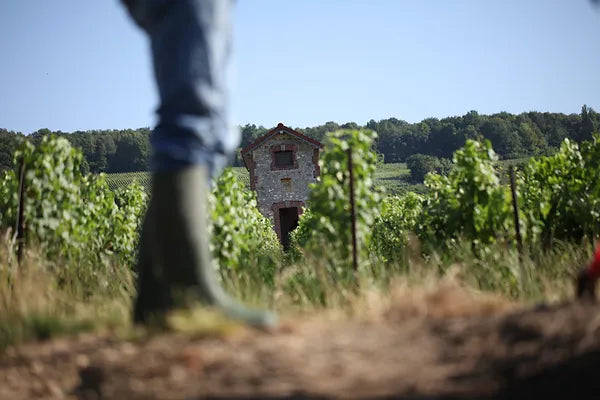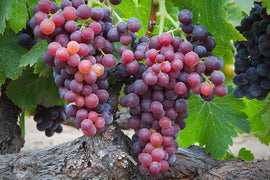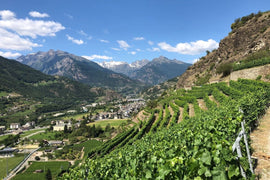Goutorbe-Bouillot
Drinking Champagne is famously fun and easy; making Champagne is notoriously laborious and difficult. And while it’s not entirely true that these properties exist in inverse proportion to one another, often as not the most beguiling bubbles flow downstream from some exquisitely fussy vigneron intervention. Lately, a small but significant contingent of local growers are following this logic south all the way to Spain, blending in new degrees of difficulty via solera, an ancient aging technique most associated with Sherry, the legendary fortified wine of Jerez. This month, we’re sampling a couple of bottles from one such producer, the Vallée de la Marne’s Gourtorbe Bouillot.
The solera (from suelo, meaning ground or floor) system, also called perpetual reserve, is kind of the opposite of vintage winemaking. Instead of representing a specific year, each bottling is a blend of every vintage since the solera was started. Picture a stack or pyramid of wine barrels: the bottom row, as the name suggests, is the solera, which contains the oldest wine; each row of barrels added on top, called criadera (first criadera, second craidera etc) comes from every year/harvest since. Wine is bottled from the barrels on the bottom, and the missing wine is then replaced with wine taken from the next youngest barrel, and then that barrel is topped off with wine from the barrel above it, and so on. New wine goes into the last barrel on the top every vintage. For example: if you start a solera with 25% wine from 2019, 25% wine from 2020, 25% wine from 2021 and 25% wine from 2022, the following year, you draw 25%, and replace it with the 2023 harvest, the soléra will now consist of 25% of 2023, and 18.75% of each of the other vintages. All that extra math in your glass in theory adds up to wines of consistent quality and ever increasing complexity, old juice mentoring young, the generations coming together to offer a trip through time, each year in the life of the wine contributing a memory.
What’s not to like? Well, the reason more winemakers don’t employ this approach is that in practice it requires a lot of attention, and carries with it significant risk. Since each year blends with the others, any issue or flaw in one barrel can easily spoil the lot. It is also expensive in that you need a lot of barrels to hold a lot of wine you aren’t making money from. Still, there are some celebrated examples out there, from distinguished names like Selosse, Henriot, and Pierre Peters, and if done right, over time all the effort can yield remarkably textured and capacious bubbly of depth and nuance.
Goutorbe-Bouillot is a fine example. A small grower Champagne estate located in the village of Damery just west of Epernay, its roots in the region and the craft stretch back to the 17th century, and encompass the genealogies of three local families. Historically, Pinot Meunier has been the dominant grape in this area, and it constitutes half of Goutorbe Boillot’s plantings. The average age of the vineyard parcels is around 35 years old, though some parcels were planted in 1930 and are almost a century old. The Reflets de Rivière Brut is a blend of 30 vintages extending from the advent of their oldest solera in 1980 to 2011. The Ru Des Charmes Brut Rose spends 30 months aging on its lees before disgorgement and, like the Reflets, has malolactic fermentation blocked to retain the natural acidity and aromas from the grapes.
|
Reflets de Rivière Brut NV |
|
|
From: Damery, Vallée de Marne |
About the Winemaking: This wine does not undergo malolactic fermentation. It is a non-vintage wine and was blended from 30 vintages from a solera started in 1980 and extending to 2011. The wine spends 3 years on the lees before disgorgement. Assemblage/Vinification: 60% Meunier, 20% Chardonnay, & 20% Pinot Noir Dosage: 8g/liter
Tasting Notes: The eye is attracted by this delicate, pale golden color, displaying very alive thin bubbles. Fine and fresh, the nose shows delicate white fruit aromas (pear and peach). Lively and vibrant on the palate, this cuvée shows a subtle creamy texture, very refreshing on the finish, with tiny citrus notes. |
|
Winemaker: Batien Papleux |
|
|
Price per bottle / Price per case: $60.99/$658.70 |
|
|
Suggested Food Pairing: Aperitif; Scallop Carpaccio |
|
|
Le Ru Des Charmes Brut Rosé |
|
|
From: Damery, Vallée de Marne |
About the Winemaking: 6 to 8% of Pinot Meunier was vinified as red wine blended into the white base for the color. No malolactic fermentation. The wine spends 30 months aging on its lees before disgorgement. 3500 bottles produced Certified Sustainable, Vegan, Practicing Organic. Assemblage/Vinification: Assemblage/Vinification: 70% Pinot Meunier, 15% Pinot Noir, & 15% Chardonnay Dosage: 8 g/liter Tasting Notes: Pale pink in color with a delicate perlage. Elegant balance on the nose with notes of white and red fruit. Roundness and elegance are the trademark of this cuvée, displaying red and black fruit, with a long voluptuous finish. |
|
Winemaker: Bastien Papleux |
|
|
Price per bottle / Price per case: $69.99/$755.90 |
|
|
Suggested Food Pairing: BBQ Chicken Wings; soft, creamy cheeses, spicy Asian cuisine |
|





